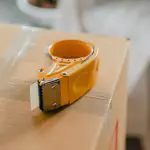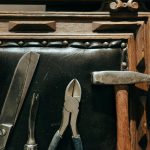You’ll need some basic tools like a staple gun, sharp scissors, and pliers to get started. Choose a durable fabric that fits your style and high-traffic needs. First, remove old fabric carefully and check your furniture frame for repairs. Next, measure and cut new padding and fabric precisely, then staple it tautly, trimming excess for a smooth finish. Adding decorative touches like nailhead trim can really elevate your piece. Keep following to master each step for a professional look.
Table of Contents
Key Takeaways
- Gather essential tools like a staple gun, sharp scissors, measuring tape, and pliers before starting your upholstery project.
- Choose durable, easy-to-clean fabric suitable for furniture use, adding 10-15% extra for pattern matching and mistakes.
- Carefully remove old fabric and padding using pliers and staple removers, preserving fabric pieces as templates.
- Measure furniture sections accurately, adding seam allowances, then cut fabric with sharp scissors for precise edges.
- Pull fabric taut, staple evenly starting from the center, trim excess fabric, and add finishing touches like nailhead trim or piping.
Understanding Basic Upholstery Tools and Materials
To get started with upholstery, you’ll need to familiarize yourself with a few essential tools and materials. Grab a staple gun—it’s your main tool for attaching fabric securely to furniture frames.
You’ll also want a pair of sharp scissors to cut your fabric cleanly and a tack hammer for driving in small nails or tacks. Don’t forget about pliers; they help remove old staples or tacks when stripping furniture.
A measuring tape guarantees accuracy when cutting materials. Foam padding and batting provide comfort and shape to your piece.
Finally, keep a curved upholstery needle handy for hand stitching details or securing tight spots. Having these basics ready will make your DIY upholstery project smoother and more enjoyable.
Choosing the Right Fabric for Your Project
Fabric choice shapes the success of your upholstery project. Picking the right fabric means balancing durability, texture, and style to fit your furniture’s use and look.
Choosing the right fabric balances durability, texture, and style for successful upholstery.
Start by considering these factors:
- Durability: Choose heavy-duty fabrics like canvas or leather for high-traffic pieces.
- Texture: Think about comfort—soft velvets feel luxurious, while woven fabrics offer breathability.
- Pattern and Color: Select patterns that hide stains and colors that complement your room.
- Ease of Cleaning: Opt for stain-resistant or washable fabrics if you have kids or pets.
Preparing Your Furniture for Upholstery
Before you start upholstering, you’ll need to remove the old fabric carefully to avoid damaging the frame.
Take time to inspect the frame and springs for any needed repairs.
Finally, clean and fix the surface to guarantee your new fabric lays smoothly and lasts longer.
Removing Old Fabric
Although it might seem intimidating at first, removing old fabric is an essential step that sets the foundation for your upholstery project.
You’ll want to work carefully to avoid damaging the frame or padding underneath. Start by gathering tools like a staple remover, pliers, and scissors.
Then, follow these steps:
- Identify and remove all staples or tacks securing the fabric using your staple remover or pliers.
- Gently peel the fabric away, working slowly to reveal layers beneath.
- Keep the old fabric intact as much as possible to use as a template for cutting new material.
- Dispose of the old fabric and any padding that’s too worn or damaged.
This process guarantees you have a clean base to apply fresh fabric smoothly.
Inspecting Frame and Springs
Once you’ve removed the old fabric, take a close look at the frame and springs to confirm they’re sturdy and in good condition.
Check for any cracks, loose joints, or signs of wood rot on the frame. Give the frame a gentle shake; it shouldn’t wobble or creak.
Next, press down on the springs to test their tension and responsiveness. If springs feel weak, sagging, or broken, you’ll need to replace or re-tie them to guarantee proper support.
Also, look for rust or corrosion on metal springs, which can affect durability.
Addressing these issues now prevents problems later and ensures your finished piece will be both comfortable and long-lasting.
Taking this time saves you from costly repairs down the road.
Cleaning and Repairing Surface
Since a clean and smooth surface is essential for successful upholstery, start by thoroughly cleaning your furniture.
Remove dust, dirt, and old fabric residue with a vacuum and a damp cloth. Next, inspect the surface for damage like cracks, dents, or loose joints.
Repair any imperfections to guarantee stability and a flat base for your new fabric. Follow these steps:
- Vacuum all nooks and crevices to eliminate dust and debris.
- Wipe down wooden parts with a mild cleaner to remove grime.
- Use wood filler or glue to fix cracks and loose joints.
- Sand repaired areas gently to create a smooth, even surface.
Taking these actions prepares your furniture for a flawless upholstery finish.
Removing Old Fabric and Padding
Before you can replace the fabric, you’ll need to carefully remove the old upholstery and padding. Start by turning the piece over and locate the staples or tacks holding the fabric in place.
Use a staple remover or pliers to gently pull them out without damaging the frame. Peel back the fabric slowly, keeping it intact if you want to use it as a pattern for your new fabric.
Once the fabric is off, remove the padding underneath. Foam or batting may be glued or stapled, so take your time to separate it cleanly. Dispose of the old materials properly.
This step gives you a clean slate to assess the frame and prepare for the new padding and fabric, ensuring a neat, professional-looking finish.
Repairing and Reinforcing the Frame
Inspect the frame carefully for any loose joints, cracks, or weak spots that could compromise your upholstery project. Fixing these issues early guarantees your piece will last longer and stay sturdy.
Start by tightening all screws and bolts. If joints wobble, apply wood glue and clamp them until dry. For cracks, fill with wood filler and sand smooth once hardened. Reinforce weak areas by adding corner braces or small wooden blocks.
- Tighten loose screws and bolts for stability.
- Apply wood glue to wobbly joints, then clamp.
- Fill cracks with wood filler, sanding smooth.
- Add corner braces or blocks to strengthen weak spots.
Cutting and Attaching New Padding
When you’re ready to add comfort to your piece, start by measuring and cutting the padding to fit its shape precisely. Use sharp scissors or an electric knife for clean edges. Lay the padding evenly over the frame, avoiding wrinkles or gaps. Attach it securely with a staple gun, spacing staples about 2 inches apart. If your piece needs extra cushioning, layer foam and batting for softness and smoothness.
| Padding Type | Thickness (inches) | Best Use |
|---|---|---|
| Foam | 1-4 | Seat cushions |
| Batting | 0.5-1 | Softens foam edges |
| Dacron Wrap | 0.25-0.5 | Adds smooth finish |
| Cotton Felt | 0.5-1 | Traditional upholstery |
| Polyester Batting | 0.5-1 | Lightweight padding |
This table helps you pick the right padding for your project.
Measuring and Cutting Upholstery Fabric
Before you start cutting, make sure you measure your fabric accurately to avoid costly mistakes.
Choose the right fabric that suits your project’s durability and look.
Use sharp cutting tools and follow simple tips to get clean, precise edges every time.
Accurate Measurement Techniques
Mastering accurate measurement techniques is essential to guaranteeing your upholstery fabric fits perfectly and looks professional. Start by using a flexible measuring tape to follow the contours of your furniture precisely. Measure twice to avoid costly mistakes.
When marking your fabric, use tailor’s chalk or a fabric marker for clear, non-permanent lines. Always add an extra 2-3 inches for seam allowance and tucking.
Here’s how to get it right:
- Measure each section of your furniture separately, noting length, width, and depth.
- Record all measurements clearly on paper or a device.
- Lay fabric flat on a clean surface before marking.
- Cut slowly along your lines with sharp fabric scissors to prevent fraying.
These steps guarantee your fabric matches your furniture’s shape perfectly.
Selecting Appropriate Fabric
Choosing the right fabric for your upholstery project sets the foundation for durability and style.
Start by considering the fabric’s weight and weave; heavier, tightly woven fabrics handle wear better. Think about the room’s use—high traffic areas need sturdy materials like canvas or denim, while decorative pieces can use lighter fabrics.
Always buy extra fabric to accommodate pattern matching and mistakes when measuring. When measuring, add at least 10-15% more than your frame’s dimensions to allow for seams and tucking.
Lay your fabric flat on a clean surface, smoothing out wrinkles before measuring. Properly measuring and selecting a fabric that suits both function and aesthetics guarantees your project lasts longer and looks great.
Cutting Tools and Tips
Three essential tools will make measuring and cutting your upholstery fabric easier and more accurate: a sharp rotary cutter or fabric scissors, a measuring tape or ruler, and fabric chalk or a washable marker.
Start by laying your fabric flat on a clean surface. Use the measuring tape to mark precise dimensions with fabric chalk. Keep your lines straight by aligning the ruler along the marks before cutting.
Here are four tips to help:
- Measure twice to avoid mistakes.
- Cut slowly and steadily for clean edges.
- Use weights or pins to hold the fabric in place.
- Always cut on a cutting mat to protect surfaces.
With these tools and tips, you’ll achieve professional-looking cuts every time.
Stapling and Securing Fabric to the Frame
Begin by pulling the fabric taut over your frame to confirm a smooth, wrinkle-free surface.
Start stapling at the center of one side, placing staples about an inch from the edge. Alternate sides, moving toward the corners to keep tension even. Use a staple gun with enough power to secure the fabric firmly but avoid ripping it.
Begin stapling at the center, alternating sides to maintain even tension and secure fabric without tearing.
When you reach the corners, fold the fabric neatly, creating sharp, clean edges, then staple securely. Check the fabric’s tension as you go, adjusting to prevent sagging or puckering.
Trim any excess fabric close to the staples to reduce bulk. Securing the fabric properly guarantees durability and a professional look, setting a solid foundation for the final upholstery steps.
Adding Finishing Touches and Decorative Details
Anyone can elevate their upholstery project by adding finishing touches and decorative details that showcase personal style.
These final elements not only enhance the piece’s appearance but also give it a polished, professional look. Start by carefully trimming excess fabric and folding edges neatly.
Then, consider these options to add flair:
- Attach decorative nailhead trim along the edges for a classic touch.
- Sew on piping or welt cord to define seams and add texture.
- Use fabric glue to secure appliques or patches for a unique design.
- Add tufting with buttons to create depth and elegance.
Frequently Asked Questions
How Do I Dispose of Old Upholstery Materials Responsibly?
Don’t toss your old upholstery like it’s yesterday’s fashion disaster. Instead, you’ll want to recycle fabrics, donate usable padding, and check local hazardous waste sites for foam or chemicals. Mother Earth will thank you!
What Are Common Safety Precautions During Upholstery Projects?
You should wear gloves and goggles to protect your hands and eyes, work in a well-ventilated area to avoid inhaling dust or fumes, and use sharp tools carefully to prevent injuries. Don’t rush and stay focused.
Can I Upholster Outdoor Furniture With This Method?
When upholstering outdoor furniture, choose weather-resistant fabrics and waterproof padding. You’ll want durable designs to defy dampness and dirt, ensuring your seating stays sturdy and stylish through sun, storms, and seasons.
How Do I Clean and Maintain Upholstered Furniture After Completion?
You should vacuum regularly, spot-clean spills immediately with mild soap and water, and avoid harsh chemicals. Rotate cushions to distribute wear evenly, and keep furniture out of direct sunlight to prevent fading and fabric damage.
Are There Eco-Friendly Fabric Options Suitable for Upholstery?
You can choose eco-friendly upholstery fabrics like organic cotton, hemp, or linen, which use fewer chemicals and resources. Bamboo fabric and recycled polyester are also great options that reduce environmental impact while keeping your furniture stylish and durable.
- The Use of Nonwovens in Construction and Civil Engineering - July 11, 2025
- The Use of Nonwovens in Construction and Civil Engineering - July 11, 2025
- The Use of Nonwovens in Construction and Civil Engineering - July 11, 2025







